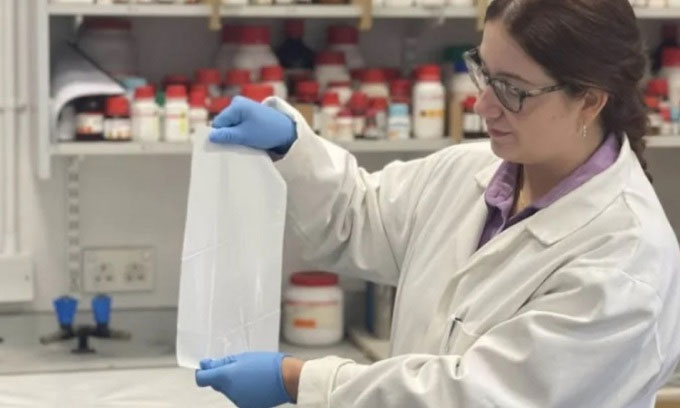Developing self-sterilizing plastic that kills viruses
The team at Queen's University in Belfast say the plastic film they have developed is cheap and can be used in protective suits. The plastic works by reacting with light to release chemicals that kill the virus. Research shows the material can kill millions of viruses, even those that stay on clothes and surfaces for a long time. The study results were published in the October issue of the journal Photochemistry and Photobiology B: Biology.

The self-sterilizing plastic film effectively killed the virus in the test. (Photo: Queen's University)
According to some studies, nCoV can survive for 72 hours on some surfaces. Norovirus that causes vomiting can survive outside the body for two weeks and wait for a new host to infect. A team of chemists and virologists is working on self-sterilizing materials that reduce the risk of infection from contaminated surfaces. Their idea is to create a material where the virus cannot survive. Copper metal can kill germs on contact but is less flexible.
So the team used thin sheets of plastic containing titanium dioxide nanoparticles. These particles react with ultraviolet light, even in small amounts from a fluorescent lamp, to release a molecule called oxygenated free radicals. They react with the genetic material of the virus. As a result, the virus dies and becomes useless.
According to Professor Andrew Mills in the chemistry department of Queen's University, the new plastic film could replace many single-use plastic films in the medical industry and help reduce the cost of sterilization. The material has been tested in the laboratory with 4 viruses including 2 influenza viruses, nCoV and picornavirus, which have many characteristics that allow them to remain highly stable outside the body. Under laboratory conditions, about a million virus particles were placed on self-sterilizing plastic, far exceeding the amount of virus needed to initiate infection.
All the viruses were wiped out in two hours, says Dr Connor Bamford of Queen's University School of Medicine. The team is looking at other surfaces such as tablecloths and hospital curtains as well as in the food handling industry. They will need field testing to determine how much of a difference self-sterilizing plastic can make.
- 3 ways to disinfect the covid-19 epidemic respirator mask with a microwave
- Plastic pollution kills half a million snails
- Quick-acting antiseptic
- Solution of 'treating' plastic garbage with cactus
- What happens to a plastic bottle after being thrown into the trash?
- Startled with the amount of plastic you are eating into your mouth every year
- How will the new enzyme destroy plastic?
- 'We have been through the age of stone, copper, iron and now plastic, which is really scary.'
- The virus survives in fresh water by attaching to plastic particles
- Signs that your phone is infected with a virus
- Scientists find the world's first reusable plastic
- India: Sterilizing monkeys disturbed the city
 'Barefoot engineer' invents a pipeless pump
'Barefoot engineer' invents a pipeless pump Process of handling dead pigs due to disease
Process of handling dead pigs due to disease Radiometer
Radiometer Warp Engine: Technology brings us closer to the speed of light
Warp Engine: Technology brings us closer to the speed of light Even if humanity becomes extinct, these three traces of humanity will still exist almost forever!
Even if humanity becomes extinct, these three traces of humanity will still exist almost forever!  Microplastics found in more than 50% of clogged atherosclerotic plaques
Microplastics found in more than 50% of clogged atherosclerotic plaques  New Biodegradable Plastic Invention Leaves No Microplastics Behind
New Biodegradable Plastic Invention Leaves No Microplastics Behind  Mealworms - a promising solution to the threat of plastic waste
Mealworms - a promising solution to the threat of plastic waste  More than 6 million tons of plastic waste are floating in rivers, lakes and oceans.
More than 6 million tons of plastic waste are floating in rivers, lakes and oceans.  Turning plastic waste into a trendy trend
Turning plastic waste into a trendy trend 